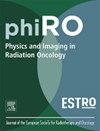一种检测椎体水平错误标记和自动轮廓错误的算法的外部验证
IF 3.4
Q2 ONCOLOGY
引用次数: 0
摘要
背景和目的本研究对先前开发的椎体自动轮廓工具进行了外部验证,并研究了一种后处理方法,以提高性能到临床可接受的水平。材料和方法来自两个独立机构(40个来自机构A和41个来自机构B)的CT扫描中的椎体被自动定位和枚举,2)轮廓,3)筛选作为质量保证(QA)错误的手段。通过计算识别率、轮廓可接受率和QA准确度来评估刀具的性能。将这些指标与模型原始训练数据集中的ct计算结果进行比较,并开发了一种后处理技术来提高工具的准确性。结果在外部数据集A和B上对未经后处理的模型进行测试时,对椎体(C1-L5)的识别率分别为83%和92%。与在模型原始测试数据集上测量的准确率和率相比,在这两个数据集上的识别率、轮廓可接受率和QA准确率都有所降低。经过算法调整后,所有椎骨的识别率平均提高了4% (p <;在数据集A上为0.01),在数据集B上为4% (p = 0.01)。结论在机器学习管道内进行后处理调整,使椎体定位精度达到临床可接受的水平。在部署到不同机构之前,对机器学习和深度学习工具进行外部验证是必不可少的。本文章由计算机程序翻译,如有差异,请以英文原文为准。
External validation of an algorithm to detect vertebral level mislabeling and autocontouring errors
Background and Purpose
This work performs external validation of a previously developed vertebral body autocontouring tool and investigates a post-processing method to increase performance to clinically acceptable levels.
Materials and Methods
Vertebral bodies within CT scans from two separate institutions (40 from institution A and 41 from institution B) were automatically 1) localized and enumerated, 2) contoured, and 3) screened as a means of quality assurance (QA) for errors. Identification rate, contour acceptability rate, and QA accuracy were calculated to assess the tool’s performance. These metrics were compared to those calculated on CTs from the model’s original training dataset, and a post-processing technique was developed to increase the tool’s accuracy.
Results
When testing the model without post-processing on external datasets A and B, accurate identification rates of 83 % and 92 % were achieved for vertebral bodies (C1-L5). Identification rate, contour acceptability rate and QA accuracy were reduced on both datasets compared to accuracies and rates measured on the model’s orginal testing dataset. After algorithm adjustment, identification rate across all vertebrae increased on average by 4 % (p < 0.01) for dataset A and also 4 % on the dataset B (p = 0.01).
Conclusions
A post-processing adjustment within the machine learning pipeline increased performance of vertebral body localization accuracy to acceptable levels for clinical use. External validation of machine learning and deep learning tools is essential to perform before deployment to different insitutions.
求助全文
通过发布文献求助,成功后即可免费获取论文全文。
去求助
来源期刊

Physics and Imaging in Radiation Oncology
Physics and Astronomy-Radiation
CiteScore
5.30
自引率
18.90%
发文量
93
审稿时长
6 weeks
 求助内容:
求助内容: 应助结果提醒方式:
应助结果提醒方式:


